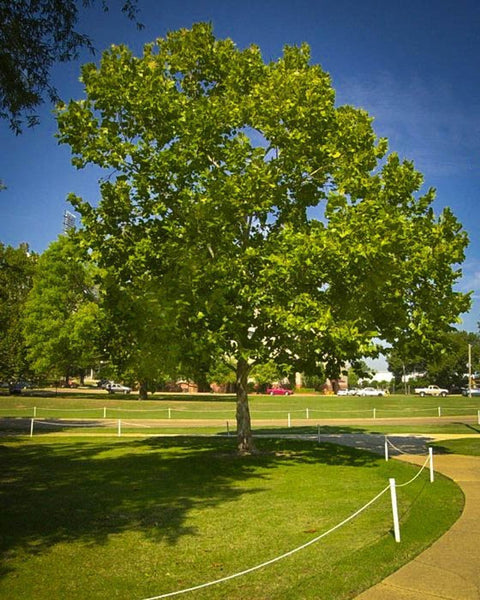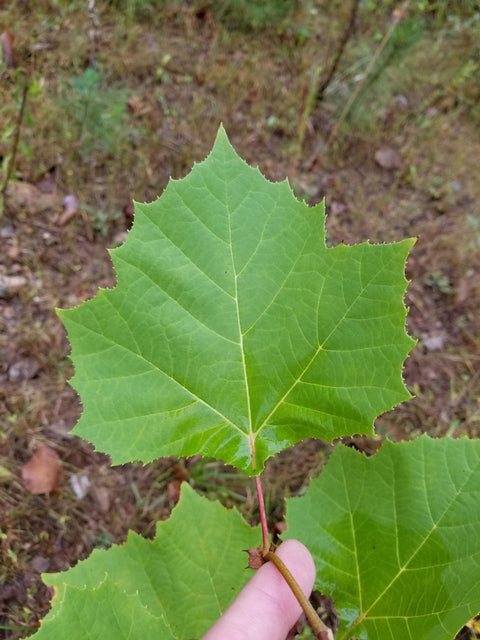

The American Sycamore tree is the largest deciduous tree popular in North America, growing to heights of 75-100 feet with a wide dome-shaped canopy. The leaves of the tree grow to about 4 to 10 inches across with lobes that are less defined. The sycamore tree grows at a rate of three to six feet per year, making it one of the fastest-growing trees that offer sublime shade. As it grows, its unique peeling bark exposes a jigsaw puzzle pattern that ranges in color from tan, white, gray, and green to orange, red, and brown. The tree features seed balls that grow to a diameter of three centimeters. This iconic tree can live for more than 200 years, with some living to be between 500 to 600 years old. This article will discuss how and where the sycamore tree grows best and why it is a great tree to purchase.
Where to Plant the American Sycamore
The size of your compound matters because these trees thrive in locations that can accommodate their size at full maturity. While the tree is adaptable to different soil types with varying pH levels, the soil shouldn't be overly wet because continuous exposure to plenty of water will kill it after a while. American Sycamore trees can be great centerpieces in a landscape. They prefer a natural space with consistent moisture, like a meadow. They can also grow next to the black walnut tree.
When and How to Plant the American Sycamore
Early spring and fall are the best times to plant the sycamore tree. Winter can also be ideal if your ground is digable. You must use much water in the summer to keep the plant healthy. When choosing the right place to plant, give the tree room to grow by planting it 60 feet away from other trees and shrubs. First, to plant, dig a hole twice the root ball size in depth and width. Then, position the tree in the middle of the hole such that the top of the root ball is flush with the ground soil. Lastly, backfill the hole with the original soil and water it well, especially during the growing season when there is no rain. Other key steps include adding about two inches of mulch around the tree to reduce watering needs. Also, remove weeds and keep the soil moist using plenty of water within the first few months to help establish the roots.
Caring Tips for the Sycamore Tree
If you plant the tree in a location where littering is not an issue, this tree requires very little care. Below are some tree-caring tips:
- Soil and water: Consistently moisturize the soil to avoid prolonged periods of dryness.
- Light: Although the Sycamore tree tolerates shades, it flourishes best with full sun.
- Temperature and humidity: The Sycamore tree adapts well to both hot summers and cold winters. It does not require specific humidity requirements but does not grow well in hot, arid climates.
- Fertilizer: A single addition of a complete tree fertilizer is sufficient. However, if the tree has suffered the loss of twigs or leaves due to a fungal infection known as sycamore anthracnose, applying nitrogen fertilizer in early spring the next year after leaves emerge will boost the growth of the foliage.
- Pruning: Sycamore trees require regular pruning to remove broken or dead branches and maintain the tree's perfect shape. The ideal pruning time is after the tree sheds its leaves in the fall and late winter.
For the plant to grow well, ensure the sycamore tree grows in the sun, with plenty of water and professional pruning when needed.
Why You Should Buy the American Sycamore Tree
There are many reasons why Sycamore trees are great choices. Here are five reasons :
- Provides shade: This tree grows fast and has extensive branches, providing shade for summer enjoyment.
- Pollution-tolerant: The sycamore tree is tolerant to road salt and pollution, making it ideal for planting along walk paths.
- Windbreaks: If you stay in exposed areas or along a coastal shore, mature sycamore trees are perfect windbreakers because they resist strong wings.
- Supports wildlife: The sycamore tree offers shelter and food to birds and insects.
- The sycamore tree is adaptable to different soil types: It can grow in different climates, soil types, and light exposures.
The tree's numerous benefits and ability to beautify a landscape make it an excellent choice for an ample space.
Ships As:
Bare root
Zone:
4-9
Exposure:
Full Sun
Deer Resistant:
Yes
Native:
Yes




